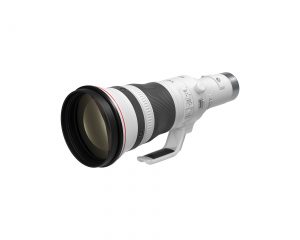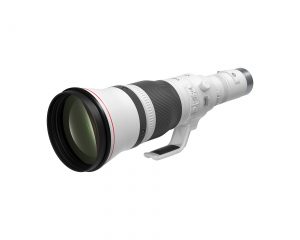Canon Introduces RF800mm F5.6 L IS USM, RF1200mm F8 L IS USM Super-Telephoto Lenses; Company Celebrates 35th Anniversary of EOS System
Story Highlights
The Canon RF lens family is growing by two, with the addition of the Canon RF800mm F5.6 L IS USM, and the longest focal length RF lens yet, the RF1200mm F8 L IS USM. In addition, the company will celebrate the 35th anniversary of the launch of the company’s EOS System in March 2022.
RF800mm F5.6 L IS USM and RF1200mm F8 L IS USM Super-Telephoto Lenses
Both super-telephoto fixed focal length lenses are quite light for their considerable abilities, and share many of the same features such as Super Spectra Coating (SSC) and Air Sphere Coating (ASC) to help minimize ghosting and flaring, compatibility with both the RF1.4x and RF2x extenders and a customizable electronic focusing ring with manual focus capability during Servo AF.
Additional features shared by both lenses include:
- Two focus presets, with the ability to instantly switch between memorized focus distances
- Circular nine-bladed aperture providing photographers with exceptionally beautiful and soft blurred backgrounds and bokeh
- Renowned Canon L-Series durability and construction with dust and water resistance, plus fluorine coating on the front element for easy cleaning
The RF800mm F5.6 L IS USM weighs in at just 6.9 lbs and features a minimum focusing distance of 8.53ft/2.6 meters — maximum close-up magnification is a superb 0.34x, allowing wildlife image creators to fill the frame with small subjects, such as birds, at its minimum focusing distance. Optical image stabilization is up to 4.5 stops* of shake correction and includes three IS operation modes. When using the RF1.4x or RF2x extenders, users can experience enhanced effective focal lengths of 1,120mm and 1,600mm respectively.
The RF1200mm F8 L IS USM is the most powerful super-telephoto lens in the Canon RF lens line. It weighs in at 7.4 lbs — an outstandingly light figure for a super-tele lens of this type — and features a minimum focusing distance of 14.1ft/4.3m. Optical image stabilization is up to 4.0 stops* of shake correction and, similar to the RF800mm F5.6 L IS USM lens, includes three IS operation modes. When using the RF1.4x or RF2x extenders, users can experience enhanced focal lengths of 1,680mm and 2,400mm, respectively.
The Canon RF800mm F5.6 L IS USM and Canon RF1200mm F8 L IS USM are both scheduled to be available in late May 2022 for an estimated retail price of $16,999.00 and $19,999.00, respectively.
35th Anniversary of EOS System
Canon’s EOS System made its debut in March 1987 with the launch of the EOS 650 single-lens reflex (SLR) camera and EF lenses1. An acronym of “Electro Optical System” while also carrying the name of the Greek Goddess of the dawn, the EOS series came to light in 1987 as the world’s first fully electronic mount system, representing a new generation of AF SLR cameras.
During the film-camera era, EOS SLR cameras received high praise from a wide range of users for their innovative technologies and designs focused on Canon’s key concepts of high-speed and ease-of-use. During this period, the company launched the top-of-the-line professional model EOS-1 in 1989. With the introduction of the compact lightweight EOS Kiss (EOS Rebel XS and EOS 500 in other regions) in 1993, Canon expanded its user base to the more consumer-orientated customer.
Following the introduction of the EOS D30 in 2000, with the rise and popularization of digital SLR cameras in full swing, Canon developed innovative models such as the high-speed and high-image-quality professional-oriented EOS-1D (2001), the EOS Kiss Digital (2003, EOS Digital Rebel or EOS 300D in other regions) which appealed to a broad user base, and the EOS 5D Mark II (2008), which featured Full HD video recording. In 2012, Canon introduced the Cinema EOS System, transforming EOS video technology and marking Canon’s entry into the video production industry.
From there, Canon continued to develop equipment for an increasingly broad range of users. In 2018, the EOS R System was born from Canon’s desire to construct the optimal rear lens element diameter and shorter distance (back focus) for a Full-Frame image sensor. The company followed up in 2020 with the EOS R5, the world’s first digital camera to feature 8K recording2. In 2021, the EOS R3 was launched, featuring eye-control AF capability and the EOS VR System for recording VR content.
Enabling visual expression through still photography, video, and even VR content, the EOS system helps to expand the possibilities of visual expression with a lineup comprising 21 EOS series cameras3 and 104 RF and EF lenses4. Further reinforcing the company’s long-running and expansive user base, Canon has maintained the world’s No.1 share5 of digital interchangeable-lens cameras since 2003 — a total of 18 years running.
Canon will continue to refine its diverse imaging technologies based on its core optical technology to create an even more robust EOS System that meets the needs of an increasingly broad user base.


